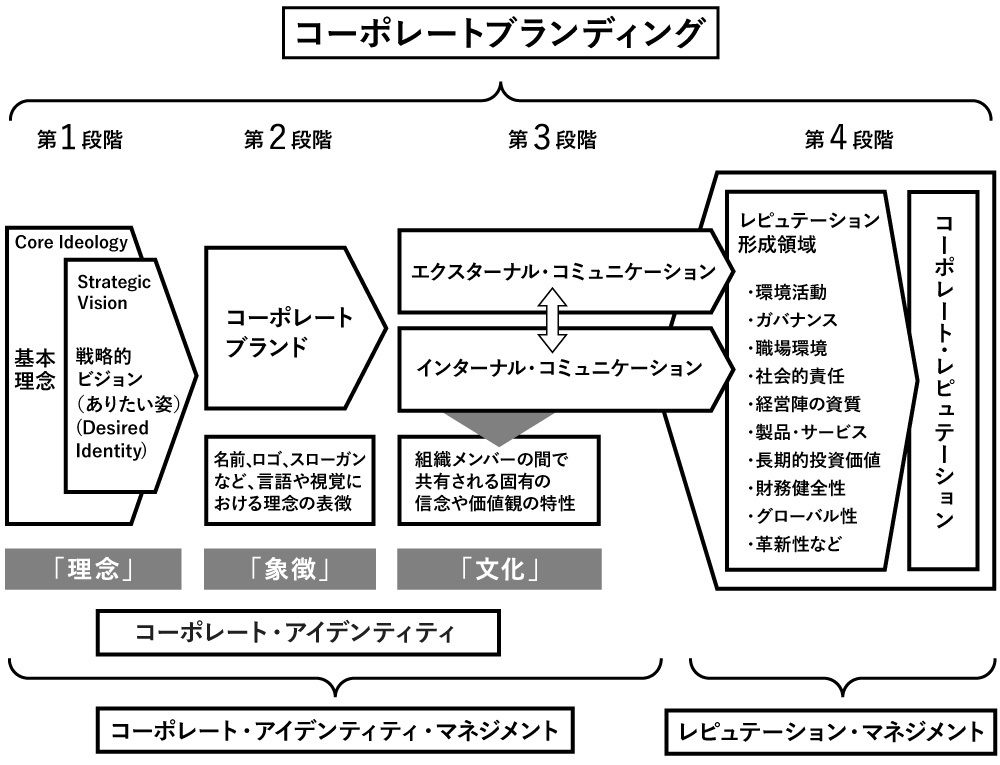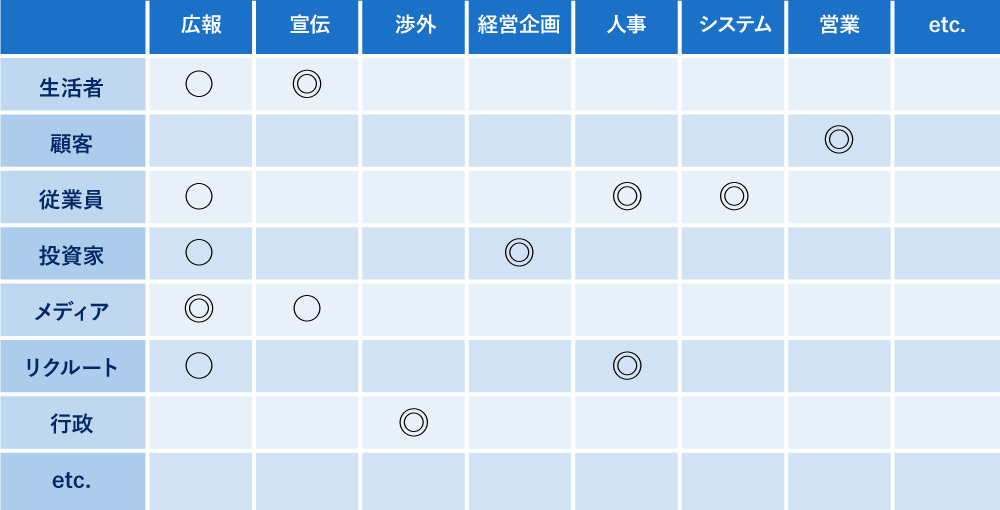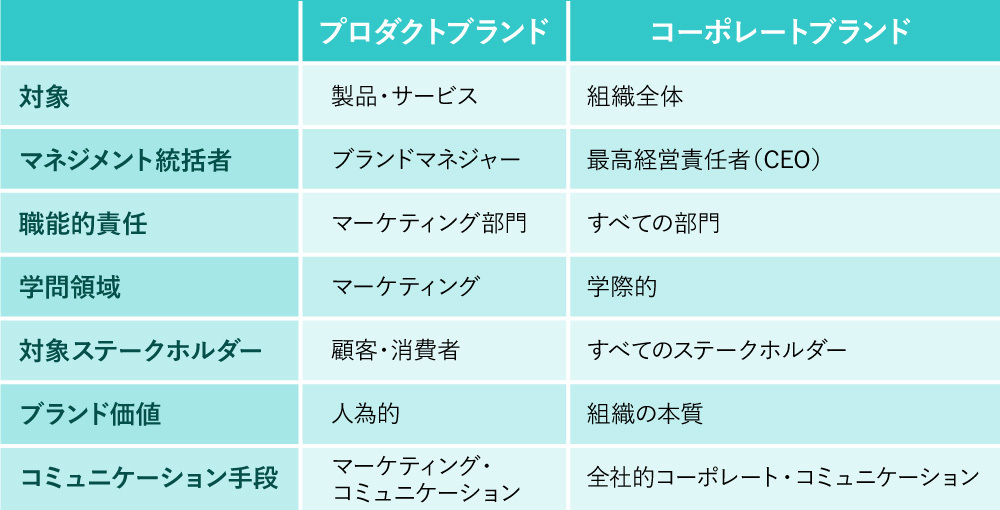To effectively advance corporate branding, what functions should your department possess? Or, how should you collaborate with other departments?
Recently, our Corporate Communications Department has been receiving more requests for consultation starting from the "organizational development" stage.
The background for this likely includes the following:
- Integration of PR and advertising departments following business restructuring (e.g., transition to a holding company structure, M&A, withdrawal from unprofitable businesses)
- Increased importance of internal communication accompanying the formulation of corporate philosophy (purpose/mission, vision, values)
- SDGs/ESG (environmental, social, governance) initiatives have evolved beyond traditional CSR (corporate social responsibility) activities to become issues directly linked to management
- Awareness of challenges in the digital shift of corporate communications
- The necessity of promoting integrated branding domestically and globally
Needs for corporate branding and internal communication arise from various catalysts. However, as challenges become more sophisticated and complex, concerns like "Our current organizational structure can't effectively drive this forward. Yet, the required actions are wide-ranging, making it difficult to determine how much functionality our department should handle" are also increasing.
This time, we explain "organizational development" for advancing corporate branding—the very "foundation" for driving internal communication.
Understanding the Big Picture of Corporate Branding
When considering the organizational structure for corporate branding, it is essential to first accurately understand "what activities are included in corporate branding."
The author, in collaboration with Kunio Inoue, Visiting Researcher at Toyo University's Institute for Contemporary Social Studies, published a paper titled " A Framework for Corporate Branding Practice: Focusing on Conceptual Clarification of Corporate Identity, Brand, and Reputation." Within this paper, the corporate branding process is defined as follows.
Figure 1: The Four-Stage Process of Corporate Branding

Corporate branding refers to "a comprehensive management process for establishing a corporate identity and forming a favorable reputation." It comprises the following four stages:
Stage 1: Formulating Foundational Principles and Strategic Vision
After formulating or reaffirming the company's fundamental principles, a "strategic vision (desired future state)" is established to clarify the direction of corporate branding.
Stage 2: Development of the Corporate Brand
The "corporate brand" symbolically expresses the company's identity through the appropriate combination of three elements: ① the corporate name, ② the visual identity (hereafter VI), and ③ the corporate slogan. It is the necessary means of expression to clearly communicate the principles and vision to internal and external stakeholders.
Stage 3: Communication Design
To enhance recognition of the corporate brand and foster stakeholder understanding, empathy, and support, designing communication strategies for diverse internal and external stakeholders is essential. We drive two key pillars: internal communication to embed the philosophy and vision within the organization, establish a new organizational culture, and reflect it in each employee's daily work; and external communication that strategically combines PESO media (Paid Media/Earned Media/Shared Media/Owned Media).
Stage 4: Building Corporate Reputation
Corporate reputation refers to "the overall assessment or cumulative perception stakeholders hold regarding an organization's ability to create value." Simply put, it is whether stakeholders evaluate the company as "a company whose products I want to buy," "a company where I want to work or continue working," and "I want to buy this company's stock and support it." It is formed over a long period of time through various communications and corporate activities. Building a positive reputation is the external objective of corporate branding and also serves as a key metric for measuring its success.
Viewed this way, corporate branding activities encompass
- involvement in formulating and communicating corporate philosophy and strategic vision
- Development and implementation of corporate names/VI/slogans
- Planning and implementation of internal communications
- Planning and implementation of external communications
- and the measurement and management of corporate reputation
These are the core functions.
Furthermore, internal communication encompasses a wide range of activities, including the company intranet, recognition programs, and training systems. External communication spans public relations, advertising (mass media/digital advertising), and investor relations (IR). First, it is necessary to take stock of which departments within the company currently handle these functions.
One point to note here is that many companies have a "brand department" under their "corporate communications division" responsible for managing and operating visual identity (VI), planning brand strategy, and measuring reputation.
In such companies, there is a tendency to position corporate branding as "one activity within corporate communications." However, as mentioned earlier, it is more accurate to position "corporate branding" as the overarching concept – a comprehensive management process for establishing organizational identity and building a favorable reputation – and to view "corporate communications (internal/external)" as one function within that process.
Inventory Your Company's Current State Using the "PR Matrix"
Which departments are currently involved in corporate branding activities, and how? To organize this, we highly recommend utilizing the "PR Matrix" proposed by Mr. Inoue, mentioned earlier.
Figure 2: PR Matrix

*◎ and ○ indicate the level of involvement (the stakeholders and departments above, and the ◎○ plot are dummy examples)
List your company's relevant stakeholders in the table header (row headers) and your company's departments in the table footer (column headers). Plot which department corresponds to which stakeholder. This alone should reveal which departments should collaborate with each other for communication with each stakeholder.
Then, while considering your company's current situation,
- Establish the department responsible for corporate branding
- Define the functions the lead department should oversee
- Establishing "Corporate Branding Representatives" in departments outside the lead department
- Regular meetings between the lead department and other departments for information sharing and progress
Keep these points in mind as you consider the optimal organizational structure for your company.
Corporate branding differs significantly from product branding, which targets specific products or services as part of marketing activities. Its defining characteristic is that it is a "company-wide transformation initiative" encompassing all departments and stakeholders. Furthermore, the most suitable person to oversee this initiative is the company's top leadership. The main differences between product brands and corporate brands are summarized in the diagram below.
Figure 3: Differences Between Product Brand and Corporate Brand

Source: Inoue, Mochizuki, & Nakamachi (2021), "A Framework for Corporate Branding Practice: Focusing on Conceptual Clarification of Corporate Identity, Brand, and Reputation"
What is now required is centralized information dissemination management
A recent trend in corporate branding organizational structures involves consolidating communication functions previously dispersed across departments—such as public relations, advertising, IR, and CSR—into a centralized unit.
A major factor driving this is the growing demand for "centralized information dissemination management," largely due to the proliferation of social media. Furthermore, the advancement of digitalization and globalization, along with the trend toward holding company structures, is accelerating the consolidation of corporate branding promotion departments.
For example, one company previously had separate departments handling communications: HR for recruitment, IR/General Affairs for shareholders, and a dedicated Sustainability department for social contributions. Under strong leadership from the top, a new department was established to integrate these activities. By concentrating budgets and enabling timely information dissemination, this approach has yielded significant results.
Companies have various management functions, each with related communication activities. These often span multiple departments and are intertwined. For instance, IR is closely linked to finance and strategic planning, recruitment communications to HR, and SDGs promotion to CSR. How to coordinate these and ensure consistency in communication activities is a major challenge. Utilizing tools like the aforementioned "PR Matrix," it is advisable to consider the appropriate balance between centralized functions and those requiring collaboration as needed, making decisions based on each company's unique circumstances.
There is no single correct answer for building an organization for corporate branding. At Dentsu Inc.'s Corporate Communications Department, we leverage our extensive experience to provide consistent support—from organizational structure to communication activities—while keeping in mind the company's DNA (values and norms), business activities, and future vision.
References:
・Inoue, K., Mochizuki, M., & Nakamachi, N. (2021). "A Framework for Corporate Branding Practice: Focusing on Conceptual Clarification of Corporate Identity, Brand, and Reputation." Public Relations Research, No. 25 (Japan Public Relations Association), pp. 4-19
https://www.jstage.jst.go.jp/article/kohokenkyu/25/0/25_4/_article/-char/ja
・"Public Relations Organizations and Personnel at Major Companies: 2020 Edition" (Economic Public Relations Center)








